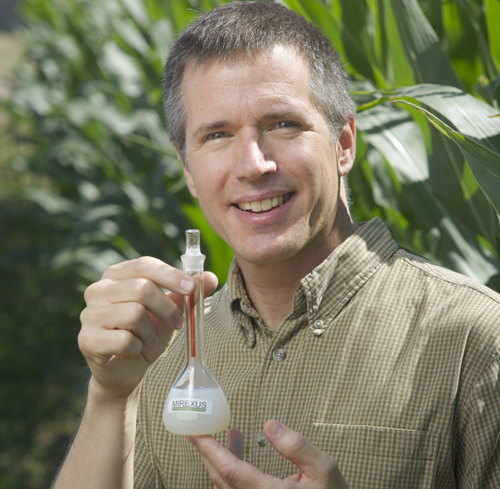Story by Natalie Osborne, a graduate of the SPARK program (Students Promoting Awareness of Research Knowledge)

Ontario cornfields could one day be the source of not only food, feed and fuel but also eco-friendly paints, age-defying super-moisturizers and non-toxic drug treatments — all thanks to tiny particles discovered in a University of Guelph lab.
The particles are sugar polymers made of sugar molecules bonded together. Their unique properties make them a promising platform technology with myriad applications. Researchers are producing these revolutionary new particles from Ontario corn.
They say the particles could serve as non-toxic, biodegradable replacements for engineered nanoparticles or petroleum ingredients. This could make any product more environmentally friendly, be it paint, cosmetics or even biomedical treatments.
“The way the sugars are arranged gives them unique physical and chemical properties,” says physics professor and project leader John Dutcher. “There are enzymes within the body and within the environment that can naturally break down these particles, so you don’t have to worry about them building up in the environment.”
Like many scientific discoveries, the particles were created by accident. One night, a postdoctoral researcher was performing a complicated chemical procedure for an unrelated physics and microbiology project. He noticed that the waste product looked peculiar, so instead of throwing it out, he put it on a shelf. The postdoc was Anton Korenevski, now a research associate in Dutcher’s polymer surface and interface group.
Eventually, Dutcher and his team took a closer look at the mysterious substance, using high-magnification microscopes. They were amazed to see perfectly round, uniformly sized spheres.
They’re so tiny, it would take half a billion particles to cover the head of a pin. Because they’re all the same size and have uniform surface chemistry, they’re easy to modify for almost any use. Before the particles can be used in greener paint products or safer medical tests, researchers must optimize the particles’ natural renewable source — southwestern Ontario corn.
Originally the particles were made from another, less readily available biomass, but researchers discovered a way to produce them from corn sugar. Dutcher and his team are now working with corn specialist Greg Stewart from the Ontario Ministry of Food and Agriculture to determine which corn varieties and harvesting practices yield the most particles. Last year, they harvested 200 kilograms of kernels and analyzed the particles produced.
For some varieties, the particle content was very high — up to 25 per cent of the weight of the corn kernel. Researchers also evaluated the physical and chemical features that make the particles unique.
One of those features is a remarkable ability to retain moisture, says Dutcher. This makes the particles a good candidate for use in cosmetics and personal-care products, an industry that generates $300 billion a year internationally. In fact, the particles retain moisture much better than the ingredients used in current high-end moisturizing products, he says. The market for personal-care product ingredients alone is expected to grow to $8 billion by 2014.
Since the particles are made from natural sugars, they could replace synthetic, potentially toxic particles used in biomedical applications, says Dutcher. The sugar particles could be modified to act like “delivery vehicles” that carry drugs or diagnostic agents to target sites throughout the body.
In addition, solutions made from the particles are highly efficient at scattering light, which makes them attractive ingredients for paints and cosmetics, where they could replace petroleum-based components, he says.
Unlike regular starch-based products, the particles have very low viscosity in solution.
“Think of the particles as hard spheres,” says Dutcher. “In water, they act like billiard balls, bouncing off one another without sticking. This means you can add a large amount to a solution before it becomes a gel, which is useful if they need to be piped around a factory.”
He and his team have named them PHYTOSPHERIX™ polysaccharide particles. A start-up company called Mirexus Biotechnologies Inc. was created to guide their marketing and production.
Pilot trials have advanced the manufacturing process from lab to industry scale, successfully producing about 70 kilograms of particles under food-grade conditions and ready for sale. Researchers are working with potential customers to tailor the particles for specific applications.
Late microbiology professor Terry Beveridge was co-collaborator on the original project. Other team members include Korenevski and Erzsebet Papp-Szabo.
Funding for this research was provided by the Partnership Agreement with the Ontario Ministry of Agriculture and Food, and the Ministry of Rural Affairs.